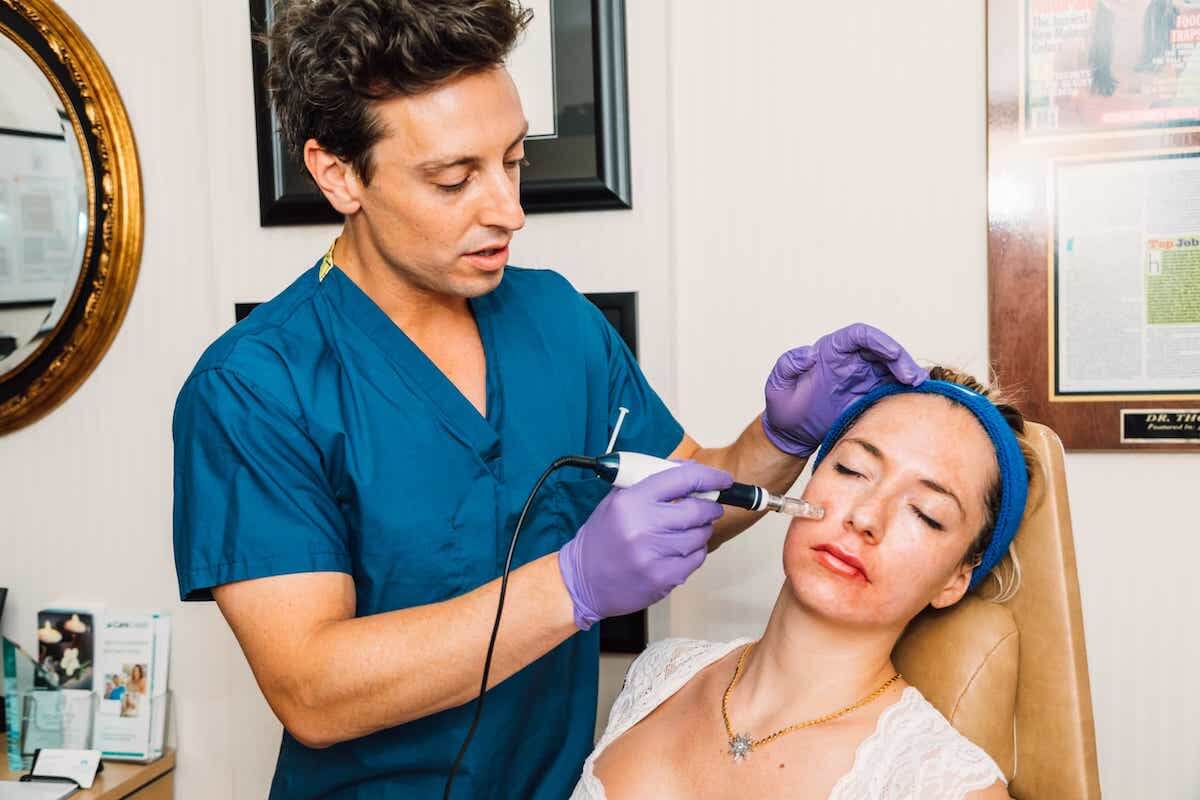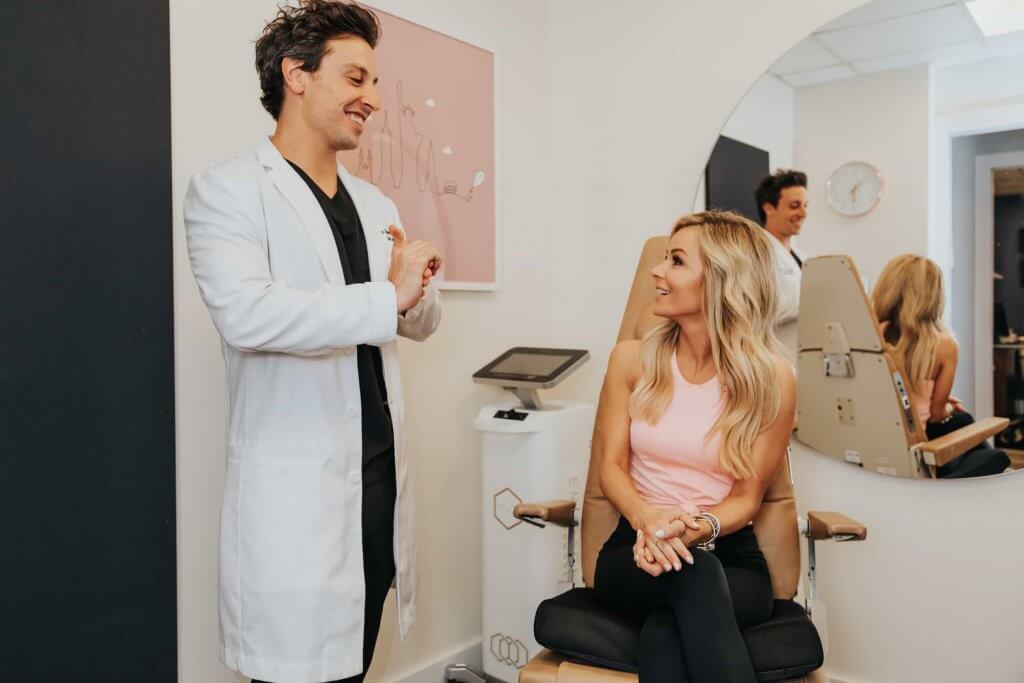We’ve all had the same horrifying experience during puberty or early adulthood—fretting over the pimple which appeared overnight, applying ointments, creams, and lotions in the hopes of reducing the size and appearance of the spot. We’ve all experienced that feeling of dread when we had to show up to school with our new-found facial friend. And for many, acne doesn’t end until much later in life. And if that is not enough, sometimes acne leaves behind scars to remind us of those dreaded breakouts.
If you have acne scarring to your face, neck or back, you are not alone. According to research published in The Journal of Clinical and Aesthetic Dermatology*, 80 percent of people between the ages of 8 and 30 years have been affected by acne vulgaris, and the vast majority have experienced some degree of acne scarring.
Fortunately, multiple treatments are now available in plastic surgery and dermatology offices to help improve the appearance of the affected skin. A multi-modal approach with a combination of treatments tailored to each patient has greatly improved the efficacy of treatment and the patient’s final appearance.
Acne Inflammation and Scarring
Before we detail the treatments, it is helpful to first understand what exactly causes acne scarring. Acne vulgaris is an inflammatory process affecting the pilosebaceous units of the face, chest, shoulders and back. A pilosebaceous unit consists of a hair follicle, a sebaceous gland and a small muscle called the erector pili muscle. These units normally produce sebum and keratin; however, when production is altered, a pimple (or comedone) forms. This can be affected by bacteria as well (especially Propionibacterium acnes (P. acnes)). The area of around the pilosebaceous unit then becomes inflamed and red. At times, these inflammatory lesions can lead to long-lasting or permanent changes in pigmentation and scarring of the affected skin. In addition, the inflammation negatively affects the skin’s wound healing properties which leads to further scarring. Multi-modal or combination treatments work to correct changes in pigmentation as well as scarring.
Treatments for Changes in Pigmentation (Skin Coloration)
Many patients, especially those with lighter skin complexions, have chronic erythema (redness) from prior acne. Several devices available in the plastic surgery office can dramatically improve one’s appearance by reducing acne-associated erythema. This can be an excellent first step to reduce the coloration changes prior to treating the scarring with different treatment modalities. The number of different lasers is quite extensive. Your plastic surgeon or dermatologist can detail his or her experience and preference among them.
One of the most common lasers for combating the redness or erythema is a pulsed dye laser (PDL). These lasers selectively break down the vascular components in the dermis by targeting a component of blood (oxyhemoglobin) within the blood vessels. Research published in The Journal of the American Academy of Dermatology demonstrated that one or two treatments with a PDL laser can result in a 68% decrease in erythema compared to untreated skin.** Further clearing can be obtained with multiple treatment sessions.
Other lasers which are effective in treating pigmentation changes are the potassium titanyl phosphate (KTP) laser, the erbium-doped fractional laser (EDL), and intense pulsed-light (IPL). Each of these treatment modalities has proven effective for reducing the erythema associated with acne. Caution is advised in patients with darker skin pigmentation, as this skin type is more prone to abnormal coloration with laser therapy. Other side effects may include temporary redness, peeling and itching. Occasionally patients will have an episode of cold sores caused by reactivation of the associated Herpes simplex virus, so the doctor may prescribe a prophylactic antiviral medication.
Treatments for Scarring
The scarring associated with acne is due to both the degradation of collagen (a key structural protein in the skin) and an impaired healing process from inflammation. This leads to scars of various depth in the skin. In some cases, excessive collagen formation can occur causing raised or hypertrophic scars. Frequently, patients will have a combination of pitted scars and hypertrophic scars.
The majority of scars (60-70%) are narrow, “icepick” scars which extend to various depths into the dermis. The remaining scars are either shallow, oval depressions are called “boxcar” scars or wide, undulating “rolling” scars.
The key to an effective scarring treatment is dependent on both the depth of the scar and the depth provided by the treatment modality. Conventional skin resurfacing modalities will treat shallow scars, but will not fully treat deeper scars. Severe scarring, such as seen with rolling scars often involve attachments to the tissue below the dermis as well. Improvement of such scars thus requires treatment of the subdermal tissues.
Chemical Peels
Traditional chemical peels and dermabrasion can be effective. With peels, various chemicals and treatment duration may be used, affecting the depth of the treatment within the skin surface. A well-trained plastic surgeon should administer chemical peels as failure to treat the skin appropriately may have deleterious consequences. Similarly, dermabrasion (which extends deeper into the skin than the micro-dermabrasion offered at many medical spas) can help treat scars but should only be done by an experienced practitioner.
Microneedling
 Another treatment which is showing promise in the treatment of acne scars is microneedling. The small needles enter the dermis and cause small areas of injury. This stimulates the formation of new collagen in the area, which is beneficial since acne scarring is often due to a localized depletion of collagen. New devices are available which couple microneedling with radiofrequency for an added benefit. As the needles enter the dermis, a pulse of energy is applied to further assist in the remodeling process. Numerous radiofrequency devices, with or without microneedling, are now available and many show promise in treating acne scarring.
Another treatment which is showing promise in the treatment of acne scars is microneedling. The small needles enter the dermis and cause small areas of injury. This stimulates the formation of new collagen in the area, which is beneficial since acne scarring is often due to a localized depletion of collagen. New devices are available which couple microneedling with radiofrequency for an added benefit. As the needles enter the dermis, a pulse of energy is applied to further assist in the remodeling process. Numerous radiofrequency devices, with or without microneedling, are now available and many show promise in treating acne scarring.
Another recent addition to traditional microneedling is the application of platelet-rich plasma (PRP) obtained from the patient through a standard blood draw to the treated skin. Recent research has shown a significant improvement to acne-scarred skin when PRP was applied compared to microneedling alone.*** These therapies have minimal associated discomfort and offer very little downtime for patients.
The lasers mentioned above for the treatment of color changes have also been shown to be effective in alleviating scars. The energy from the laser enters the dermis, which increases the production of growth factors and stimulates fibroblasts. These cells then produce new collagen in the treated areas. Ablative lasers, such as carbon dioxide (CO2) or Erbium lasers, can be applied to various depths and lead to regeneration of the overlying skin. Non-ablative lasers, such as Q-switched Nd:YAG, EDL, Alexandrite and Er:glass lasers, offer a more mild treatment. Different lasers will cause various levels of discomfort and length of recovery. In general, non-ablative lasers will require less downtime, however more treatment sessions may be required. Regardless of the treatment modality used, new collagen formation will take place over several months to a year.
Fillers
Another treatment for depressed acne scars is injectable fillers. These are particularly effective in treating icepick and boxcar scars. An experienced injector will have knowledge of numerous fillers and their associated characteristics and potential collagen-building properties. Each filler has a different lifespan within the skin. With temporary or semi-permanent fillers, repeated treatments are necessary. Numerous fillers have been shown to stimulate collagen production by fibroblasts, which will also improve the appearance and character of the damaged skin.
Similarly, the injection of fat cells or the smaller components of fatty (adipose) tissue has shown promise in improving both the depth of scars as well as the skin quality. With facial fat grafting, a sample of fat is obtained using local anesthesia, often from the abdomen or thigh, and the fat is processed and injected to the treatment areas in a manner similar to that of facial fillers. Filtration of the fat to obtain smaller particles such as stem cells has been shown to rejuvenate and improve the overall appearance of the affected skin.
Punch Excision
Another option for icepick or boxcar scars is punch excision, in which a small punch just larger than the scar is made in the skin. The small punch wound is then sutured with a single stitch or left to heal without a suture.
Subcision
For rolling acne scars, a procedure known as subcision can be very effective, especially when combined with the subsequent injection of facial fillers or fat grafting to the treated area. This procedure involves inserting a needle under the acne scar and releasing the dermis from the underlying subcutaneous tissue to which it is anchored. This elevated the scar and induces new collagen formation. This can be used for difficult-to-treat icepick or boxcar scars as well. The addition of fillers or fat grafting to the underlying tissue can help prevent recurrence and further scarring and fill in the space formed after scar release.
Multimodal (Combination) Therapy Is Key
As we have discussed, acne scars vary in their depth, shape, location, extent, and coloration. The same patient often has different types of scars with different appearances in multiple locations. This makes multimodal treatment the best option for an optimal result. Often, patients will need therapies to treat discoloration, to reduce the depression in the skin, and to improve the overall skin quality. In addition, given the differences in the scars, repeated sessions of each therapy may be required. The key to developing an effective treatment plan is to partner with a well-trained plastic surgeon or dermatologist—one who is knowledgeable and experienced in each treatment modality.
*Connolly D., et al. (2017) Acne scarring—Pathogenesis, evaluation, and treatment options. The Journal of Clinical and Aesthetic Dermatology. 10(9): 12-23.
**Alster and McMeekin. (1996) Improvement of facial acne scars by the 585 nm flashlamp-pumped pulsed dye laser. J Am Acad Dermatol. 35:79-81.
***Asif M., et al. (2016) Combined autologous platelet-rich plasma with microneedling verses microneedling with distilled water in the treatment of atrophic acne scars: a concurrent split-face study. J Cosmet Dermatol. 15:434-43.

